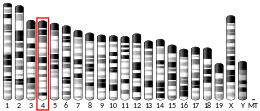PTCH2
Patched 2 is a protein that in humans is encoded by the PTCH2 gene.[4]
| PTCH2 | |||||||||||||||||||||||||||||||||||||||||||||||||||
|---|---|---|---|---|---|---|---|---|---|---|---|---|---|---|---|---|---|---|---|---|---|---|---|---|---|---|---|---|---|---|---|---|---|---|---|---|---|---|---|---|---|---|---|---|---|---|---|---|---|---|---|
| Identifiers | |||||||||||||||||||||||||||||||||||||||||||||||||||
| Aliases | PTCH2, PTC2, patched 2 | ||||||||||||||||||||||||||||||||||||||||||||||||||
| External IDs | OMIM: 603673 MGI: 1095405 HomoloGene: 37842 GeneCards: PTCH2 | ||||||||||||||||||||||||||||||||||||||||||||||||||
| |||||||||||||||||||||||||||||||||||||||||||||||||||
| |||||||||||||||||||||||||||||||||||||||||||||||||||
| |||||||||||||||||||||||||||||||||||||||||||||||||||
| |||||||||||||||||||||||||||||||||||||||||||||||||||
| Wikidata | |||||||||||||||||||||||||||||||||||||||||||||||||||
| |||||||||||||||||||||||||||||||||||||||||||||||||||
Function
This gene encodes a transmembrane receptor of the patched gene family. The encoded protein may function as a tumor suppressor in the hedgehog signaling pathway.[4]
Clinical significance
Alterations in this gene have been associated with nevoid basal cell carcinoma syndrome, basal cell carcinoma, medulloblastoma, and susceptibility to congenital macrostomia.[4]
References
- GRCm38: Ensembl release 89: ENSMUSG00000028681 - Ensembl, May 2017
- "Human PubMed Reference:". National Center for Biotechnology Information, U.S. National Library of Medicine.
- "Mouse PubMed Reference:". National Center for Biotechnology Information, U.S. National Library of Medicine.
- "Entrez Gene: Patched 2".
Further reading
- Fujii K, Ohashi H, Suzuki M, Hatsuse H, Shiohama T, Uchikawa H, Miyashita T (2013). "Frameshift mutation in the PTCH2 gene can cause nevoid basal cell carcinoma syndrome". Familial Cancer. 12 (4): 611–4. doi:10.1007/s10689-013-9623-1. PMID 23479190. S2CID 12582274.
- Smyth I, Narang MA, Evans T, Heimann C, Nakamura Y, Chenevix-Trench G, Pietsch T, Wicking C, Wainwright BJ (1999). "Isolation and characterization of human patched 2 (PTCH2), a putative tumour suppressor gene inbasal cell carcinoma and medulloblastoma on chromosome 1p32". Human Molecular Genetics. 8 (2): 291–7. doi:10.1093/hmg/8.2.291. PMID 9931336.
- Zaphiropoulos PG, Undén AB, Rahnama F, Hollingsworth RE, Toftgård R (1999). "PTCH2, a novel human patched gene, undergoing alternative splicing and up-regulated in basal cell carcinomas". Cancer Research. 59 (4): 787–92. PMID 10029063.
- Rahnama F, Toftgård R, Zaphiropoulos PG (2004). "Distinct roles of PTCH2 splice variants in Hedgehog signalling". Biochemical Journal. 378 (Pt 2): 325–34. doi:10.1042/BJ20031200. PMC 1223965. PMID 14613484.
- Evans, D. G.; Farndon, P. A.; Adam, M. P.; Ardinger, H. H.; Pagon, R. A.; Wallace, S. E.; Bean LJH; Stephens, K.; Amemiya, A. (1993). "Nevoid Basal Cell Carcinoma Syndrome". PMID 20301330.
{{cite journal}}: Cite journal requires|journal=(help) - Li TJ, Sun LS, Luo HY, Yuan JW, Gao L, Gu XM, Li XF, Xu LL (2009). "Studies on keratocystic odontogenic tumors". Beijing da Xue Xue Bao. Yi Xue Ban = Journal of Peking University. Health Sciences. 41 (1): 16–20. PMID 19221557.
- Fan Z, Du J, Liu H, Zhang H, Dlugosz AA, Wang CY, Fan M, Shen Y, Wang S (2009). "A susceptibility locus on 1p32-1p34 for congenital macrostomia in a Chinese family and identification of a novel PTCH2 mutation". American Journal of Medical Genetics Part A. 149A (3): 521–4. doi:10.1002/ajmg.a.32647. PMID 19208383. S2CID 2328208.
- Carpenter D, Stone DM, Brush J, Ryan A, Armanini M, Frantz G, Rosenthal A, de Sauvage FJ (1998). "Characterization of two patched receptors for the vertebrate hedgehog protein family". Proceedings of the National Academy of Sciences of the United States of America. 95 (23): 13630–4. Bibcode:1998PNAS...9513630C. doi:10.1073/pnas.95.23.13630. PMC 24870. PMID 9811851.
- Villavicencio EH, Walterhouse DO, Iannaccone PM (2000). "The sonic hedgehog-patched-gli pathway in human development and disease". The American Journal of Human Genetics. 67 (5): 1047–54. doi:10.1016/S0002-9297(07)62934-6. PMC 1288546. PMID 11001584.
This article incorporates text from the United States National Library of Medicine, which is in the public domain.
This article is issued from Wikipedia. The text is licensed under Creative Commons - Attribution - Sharealike. Additional terms may apply for the media files.

